Leitz 90mm Thambar f/2.2
By: Thorsten Overgaard
A long love story and a short encounter with the legendary Leitz 90mm Thambar f/2.2 portrait lens. And still no conclusion ...
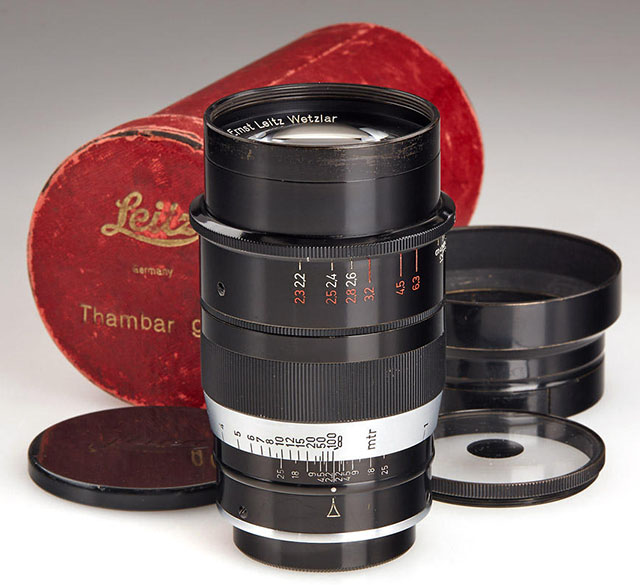
A complete set of a Leitz 90mm Thambar f/2.2 consist of the original red box, lens cap, lens shade and the special soft focus filter with a black dot in the middle.
The Leitz 90mm Thambar f/2.2
There has been quite a few Leica 90mm lenses made over the years, and they can all be fitted onto any modern Leica M camera.
But one Leica 90mm seem to keep us sleepless even it was made in 1935 to 1940, and only in 3,000 samples. It's the Leica 90mm Tahmbar f/2.0 which was made as a deliberately soft-focus lens. It even came with a Soft Focus filter that would blur the center of the image; so as to assure that everything was blurred!
Also known as the worst ever designed lens!
If you paid attention in the section above about the Leica 90mm APO-Summicron-M ASPH f/2.0 and the ability to record micro details, then you will understand better how a lens can be both blurred and detailed at the same time.

A complete set of a Leitz 90mm Thambar f/2.2 consist of the original red box, lens cap, lens shade and the special soft focus filter with a black dot in the middle. They exist in both a Meter and a Feet edition (the focusing scale). Only 3,500 or less were made from 1934-1940, from serial number 226001 to 540500.
Technical data on the Thambar
The Thambar is both a limited lens, and (for this reason also) a collectors item. That means that the price for this ugly old blurred lens goes from €2,500 to €6,000 depending on how well it is maintained, as well as what it comes with.
The lens hood is not important if you want to use the lens, but if you are a collector, it is mandatory. The soft filter is great to have if you use the lens, but in reality you could make one yourself from any 48mm UV-filter and a piece of black tape. But if you are a collector, both the filter, the lens cap and the rather useless original red box is mandatory. Hence the price difference.

Princess Joy Villa in Rome. Leica M Monochrom with Leica 90mm Thambar f/2.2. This one is in Lightroom, then extra geytones in the skin and more overall contrast achieved with the Silver Efex Pro, using the Kodak CN Pro 400 setting.
Only one type of Thambar is of no interest for anyone, and that is the few ones with "fungus" which is a live organism that attacks the glass and makes tiny "worm stripes" in the glass.
One could say that a few defects more or less in a Thambar would perhaps only make it more of a Thambar, but the problem with "fungus" is that you can't get rid of it. It occurs in conditions of darkness and humidity, and from there it grows and increases over the years as if it was a seed planted to take over the world one day (which I cannot rule out, though it will take a few thousand years before any existing "fungus" will grow large enough to scare a mouse!).
My first Thambar experiments

Hong Kong February 2011, wide open at f/2.2 without the soft filter.
When in Hong Kong in February 2011 I stumbled over four (4!) Leica 90mm Thambar f/2.2 lenses in the camera district and had the chance to test one of them with help from Steven Collins (as assistant holding a silver reflector) and Derek Young (as model).
I've been in love with this lens for a long time but never been able to find examples of use for what it is in fact intended for: Soft portraits as the ones that were popular in the 20's and 30's in Hollywood (some made with large format cameras with Vaseline on the lens).
It gave me an idea what it was about, and also about the troubles I would subscribe to in case I bought it. I was indecesive if I really needed this defect beauty in my life for another three years, till I finally found a Thambar at the Leica Shop Vienna when I visited to buy a filter (at least that is the official explanation). They of course didn't have the filter. But they had the Thambar and I had little defences left.
Thambar in colors
I got to work with the Thambar a little over the next days, in Rome. It is frustrating, and at times I can't decide if it looks to be as promising a relationship as I hoped, or if I have inherited an old color television from East Berlin where the antenna needs adjustment.
The Thambar is not impossible for color photographs. They colors didn't exist in the Hollywood portraits, nor the lens was designed. But they do now. It's just raising the bar even higher controlling overflow, flare and the colors in a lens that is was clearly not designed for the colors we expect today.
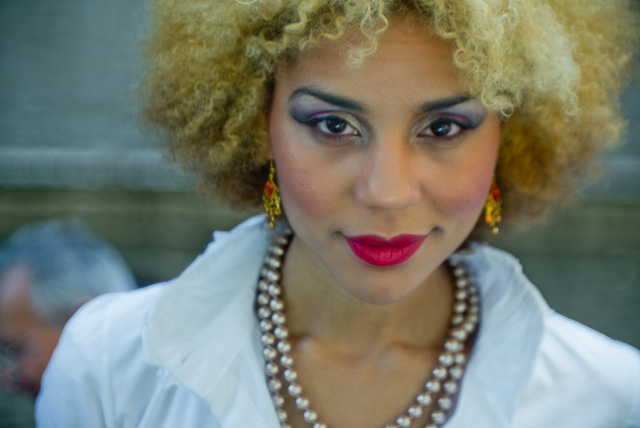
Princess Joy Villa in Rome, in colors. Leica M 240 with Leica 90mm Thambar f/2.2 at f/3.2 with center spot soft filter.
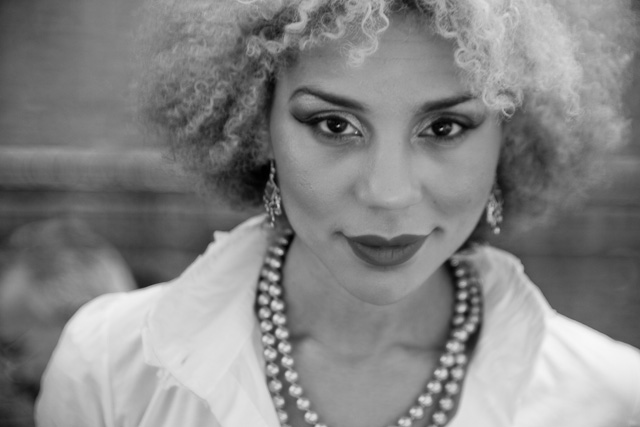
Princess Joy Villa in Rome, in black and white from the JPG Fine file in the camera.
Leica M 240 with Leica 90mm Thambar f/2.2 at f/3.2 with center spot soft filter.
The ultimate portrait lens
The Thambar fullfilled a need in the 1930's for a portrait lens that would produce the same (female) portraits as rolled out from Hollywood. The dreamy soft skin and friendly characteristics, yet with all the other details intact than the small imperfections.

My daughter Robin Isabella von Overgaard. Leica M 240 with Leica 90mm Thambar f/2.2 at f/3.2 with the soft center spot filter. "That is beautiful," was her reply. I am on the right path..!
For us who fight with making portraits with this lens today it may sound unrealistic that photographers in the 1930's and 1940's used the Thambar as their main portrait lens, but they did! Indoor and outdoor. The Thambar was the new wonder-tool for photographers who dealt with people who want to look younger and more beautiful than reality.
The blurred look, what we would call lack of technical quality in our days, was less important than the fact that the aim of looking younger and more perfect was obtained.
I know a photographer in Denmark who is very popular with the female models. His photos are always slightly blurred, with the result that they look younger and had perfect skin. One day I asked him what the secret was, and his answer was simply "1/15 of a second".
With a medium format camera, the resulting motion blur at 1/15 second will remove the thin lines even a professional model would like to live without.
But there are two problems with using the Thambar.
Strong backlight
One is understanding that it is best used with strong light behind the person. It's an effect lens that is supposed to make the light and the face glow. It is not a precision lens meant to record details. You are working on creating a dream image, not a recording!
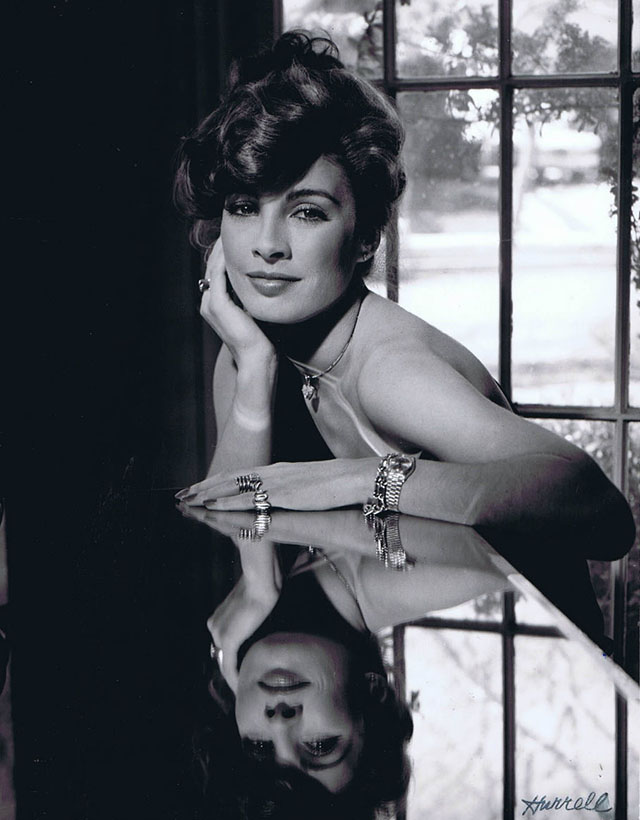 This is how any woman wants to look: Anne Archer photographed by George Hurell in 1977. Beautiful then, beautiful now. This is how any woman wants to look: Anne Archer photographed by George Hurell in 1977. Beautiful then, beautiful now.
This is quite easy to understand, especially if one starts analysing the light settings of for example George Hurell (also known as "The Rembrandt of Hollywood" in 1930-1940) and the way he set the light with usually two strong light sources from behind and above. The face was in shadow, with reflections often from a white sofa or other surface the movie stars face was resting on.
George Hurell was using a large format camera (and I thought he used Vaseline on the lens to blur the image a little. But I have learned that he used a large Wollensak Verito lens on his 8x10 camera; often stopped down to ensure sharpness). He used "heavy retouching" in a day and age where you had people painting the images imperfections away.
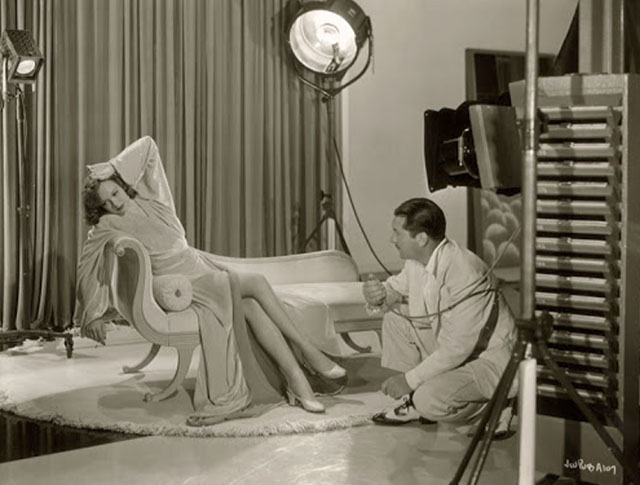
This is how any photographer wants to work and how I imagined my life would be when I got the Thambar. making any woman look glowingly amazingly beautifull! (This is Max Munn Autrey at work).
The Thambar in theory is then the perfect tool to obtain all this beauty requested. Except for one small detail that becomes quite obvious when you attach it to a modern digital camera as the Leica M 240:
This lens does not have very good control of light and colors! The perfection of modern Leica lenses is exactly that they can isolate light and shadow with no overlap or overflow, that it can isolate each Red, Green and Blue light ray very precise so you obtain very accurate colors, very good shadow details, high contrast and a minimum of lens flare - and even small light rays from strong backlights won't be overflowing what must be shadows!
The Thambar is not a modern lens with those qualities. The result being that if there is too much light, or the light source(s) are not controlled very precise and elegant, you get an overflow of light. Very bad colors, very soft contrast and simply not the magic image you dreamt about all the hours you were surfing eBay for Thambar lenses and hiding pocket money behind the book shelf so as to one day be able to buy this wonder of a lens!
The other problem using the Thambar is:
Photoshop vs. the natural look
Thambar was deviced and put into production at a day and age where basically no technology existed that would allow one to make a person look magic and beautiful. The question could very well be if that technology now exists as Photoshop and other software to make an old face look like the surface of a brand new BMW.
It may not be a very well known fact for many, but today when you see an advertisement for H&M with Beyonce by a pool, it's not her legs, skin or hair anymore. It's all "enhanced" to give us the impression that if a modern woman wears this H&M bikini top and bottom (for only $28), she will be perfect!
H&M had to correct that by releasing the original images because Beyonce knows she looks good enough without having her hips corrected by some young retoucher with acne.
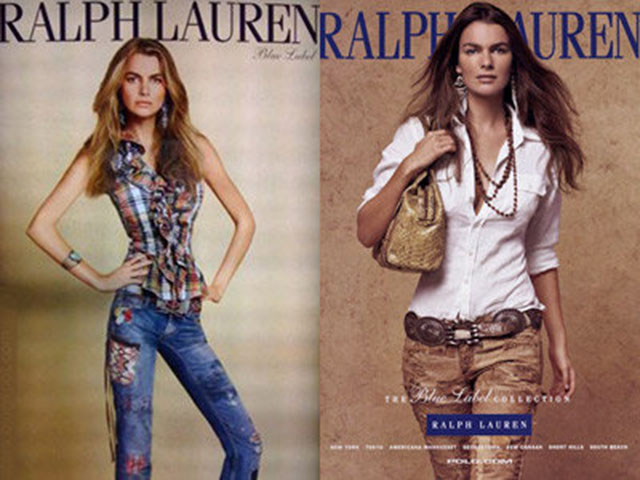
This is how Ralph Lauren "improved" the same models look in the same printed campaign. They excused for bad photoshopping (not for altering the model and introducing aliens in fashion).
Likewise, hardly any fashion cover resembles the image the photographer took with his camera. The skin, the hair, the eyes, the teeth and even the face shape has all been "improved" in the computer.

An example of a magazine cover "optimized" so the reader can "learn to look and feel their hottest" . It is quite invalidating to be photographed for a frontpage, and then learn that they didn't like your look. And the elbow as well that has been "modernized".
The problem with the Thambar is that it could perhaps easily be mistaken for a very bad performed photoshop attempt to make it look "different".
The task you as a Thambar user is faced with, in short, then is how to make it look magic and beautiful. And natural made.
Which is not a bad thing to do. In a way, that is what is the real art. Without tricks, with light and natural means to put emphasis on what is beautiful in a person, and hide what is less desireable to show.
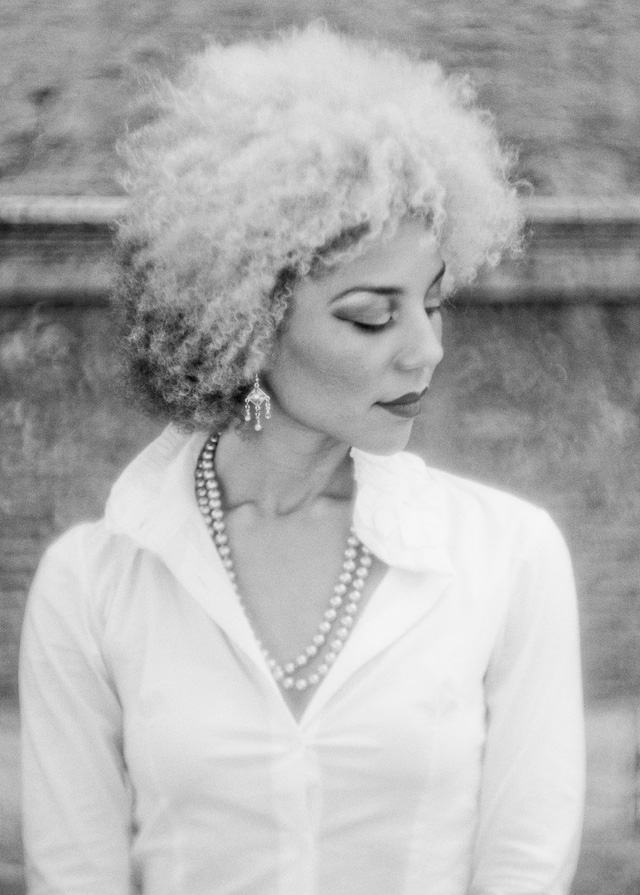 Princess Joy Villa in Rome. Leica M 240 with Leica 90mm Thambar f/2.2 at f/4.5, with the soft center spot filter. Princess Joy Villa in Rome. Leica M 240 with Leica 90mm Thambar f/2.2 at f/4.5, with the soft center spot filter.
The original brochure of the Thambar said that "this lens is for the professional who knows what he is doing", and that may be even more true today.
The only comfort in case of total failure producing anything historic with this lens is that it is a collectors item. The price will continue to go up simply caused by the fact that the lens is limited, and as time goes by some will fall apart or get lost in a fire.
You can always get your money back for the lens, should you decide to abort the mission.
Understanding the Thambar
The original manual for the Leitz Thambar from E. Leitz, Inc., 730 Fifth Avenue in New York makes as much sense as moderne manuals for Leica products. Which is not that much. But it does give a direction of the thinking.
Obviously, it helps to travel back in the time machine to the 1930's to understand it. The manual mentions that objects with extremely strong contrast may show differences of intensity of 1000:1 negatives may show contrast of 100:. But it also states that such negatives can never be printed or enlarged direct without losing tone rendering in the highest lights and the deepest shadows, since the photographic paper cannon reproduce a contrast of light values exceeding 20:1 or at the most 30:1.
It's clearly a different world today, which is why I mention this. Digital images with the Thambar on a Leica M 240 will reproduce much different today than the chemistry of the 1930's.
Deliberately spherical aberration
TThe idea with the Thambar is to create a "sunny image" with some "haloes", but not too extreme. The essential characteristic of a soft-focus lens is that certain aberrations - notably the chromatic and spherical aberrations - are deliberately left incomplete corrected. In the case of the Thambar Leitz decided to go with "the residual spherical aberration".

Spherical uncorrected versus Spherical corrected. I feel that Leitz didn't design this but simply must have found a way to not optimize the lens. In other words, they left the office early that day, and I am left with the problem making something beautiful out of those light rays hitting all the wrong places!
You should have bought it when it was new
It appears that one of the arguments for the Thambar back when it was new, in the 1930's and 1940's was that it was more economical due to the less correction. A good lens was more expensive, and particular a good f/2.2 lens that was also rich on contrast at f/2.2 would be much more expensice to acquire.
The logics basically is that the lens is rather good at f/9.0 and then grows increasingly aberrated as you open it up to f/2.2. And the manual basically says that the wider you open up the aperture, the less lens you get.
And somewhere in-between you get the Thambar look.
Without much interst in the project my daughter Robin Isabella volunteered (nevertheless) in making a few examples.
| With soft filter: |
|
|
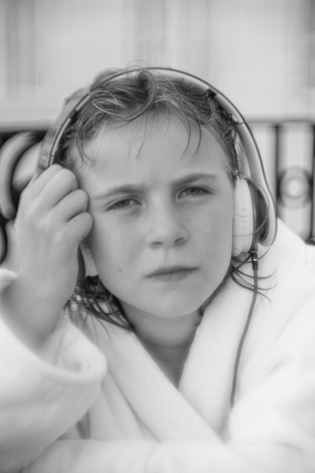 |
|
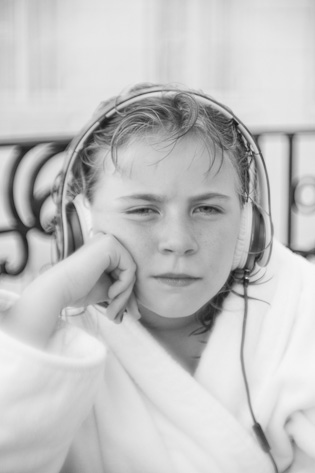 |
| f/2.2 with soft filter |
|
f/3.2 with soft filter |
| |
|
|
 |
|
 |
| f/6.3 with soft filter |
|
f/9.0 with soft filter |
| |
|
|
| Without soft filter: |
|
|
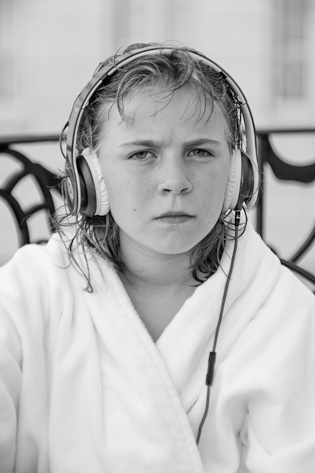 |
|
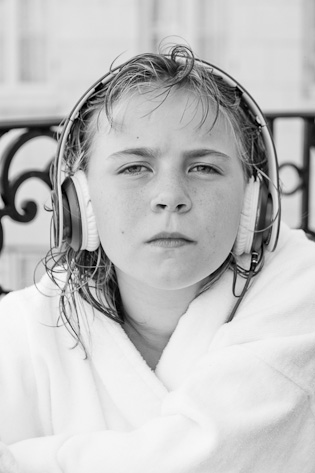 |
| f/4.5 without soft filter |
|
f/9.0 without soft filter |
This makes some sense after having used the lens for a short while. At f/2.2 it seems almost too much, whereas at f/3.2 and f/4.5 it has the glow and perhaps "sunny image" that a Thambar should have. At f/9.0 to f/25 you might have bought any lens as it ceases to have a special "sunny image" or the intented "haloes".
As you may be able to imagine, I have had to adjust my thinking to this as I always use all my lenses wide open. But I think I will have to rewise my use of the Thambar on this if I am to ever make any decent results. F/3.2 to f/6.3 seem to be my test zone for the time being.
The scale for soft filter - the red and the white f-stops
The Thambar features a red scale of f-stops (from f/2.2 to f/6.3) where the soft focus filter may be attached to obtain the soft-focus also in the center. When entering the white scale (from f/9.0 to f/25.0) the soft-filter will result in a black dot in the center of the image. In other words, only use it from f/2.2 to f/6.3 for the desired soft focus all over the field (if avoiding more sharpness in the center of the image is your goal).
Next thing: Finding the right light
The next project in learning to make any woman look like a rare diamond is then the light. There cannot be too much as it will overflow the image. On the other hand there need to be some light from the background, some bright edges and a fairly wellit face to make the "sunny images" come about.
It's not easy. Then again, nobody said it would be.

American actor Terence Hines in July 2014 in Hollywood, working with bubbling expressions
Leitz 90mm Thambar for music videos
In May 2014 I used a Thambar for music video in Vienna. Built-in special effects, as you can see. It is quite obvious a very special look:

We used four Leica M 240 cameras and different lenses for this Joy Villa music video for her song "Beautiful".
Other resources to the Leitz Thambar
Shutterbug: "The Leitz Thambar 90mm f/2.2 - Why Is It Considered A Legendary Portrait Lens?" (By Roger W. Hicks, April 1, 2005).
Advice on use
Here are some advice from a Thambar user, Theodor Heinrichsohn, who have used it mainly for portraits using an Leica M5 and Leica M6. When I asked in the Leica User Forum, this was his advice:
"1. The results are more or less unpredictable. Best practice is to shoot many times and pick the one you like best.
2. Shots against the light are generally more effective than with the light behind you.
3. The most pleasing results to my taste were with center filter at medium apertures. With luck portraits took on the "dreamy" look that the lens is famous for.
4. I never used the Thambar for anything except portraits."
Galleries:
Here are some sample photos of Koichiro Itamura Photography.
Here are some more sample images from Blue Penguin.
LFI deals with the Leitz 90mm Thambar f/2.2 in an early issue. I still have to dig out the issue and will refer to it later. You can get hold of LFI backissues at www.LFI-Online.de
|
![]()
